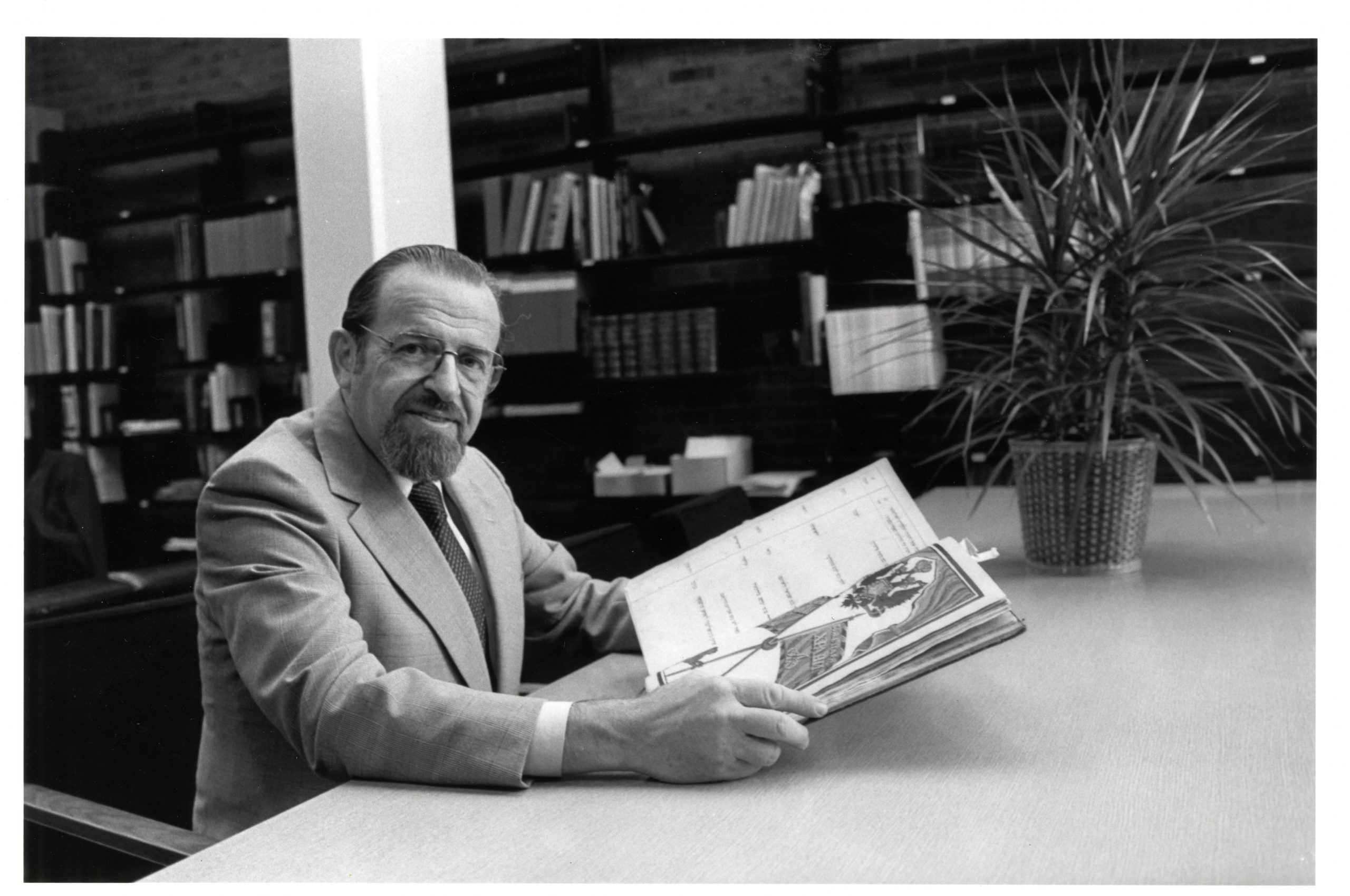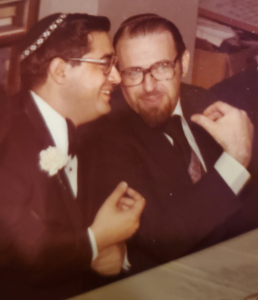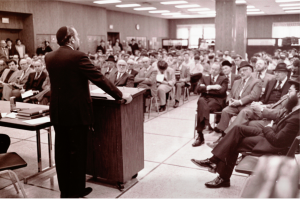Darshan for the Ages

Rabbi Dr. Norman Lamm with a manuscript, Psalms for the Tsar, 1986. Courtesy of Yeshiva University Archives
Rabbi Dr. Norman Lamm 1927-2020
Editor’s Note: This article is an expanded version of remarks delivered at a memorial tribute for Rabbi Dr. Norman Lamm held during shivah on June 2, 2020.
In sharing my memories of Rabbi Dr. Norman Lamm, I want to focus not on my connection to him as a faculty member at Yeshiva University, but on a different and more personal connection that goes back almost sixty years. Even so, these thoughts are only partly about what Rabbi Lamm means to me; they are also about what he meant to World Jewry well before he became president of Yeshiva University, and about what his labors will mean for generations to come. As I reflect, every fiber of my being is filled with gratitude to him, with hakarat hatov—but also with inexpressible sadness, a sadness that already began with the passing of Mrs. Mindella Lamm just six weeks before her husband’s petirah.
When Rabbi Dr. Ari Berman was rabbi of The Jewish Center, he wrote about Rabbi Lamm’s sermons, “The words he spoke changed the lives of our members.” Mibesari echezeh: I can testify to that from my own experience. When I was thirteen, right after my bar mitzvah, my family moved from the suburbs to the Upper West Side. My father, who loved divrei Torah, said to me shortly after we moved, “David, I just heard a fantastic speaker. You’ll love his sermon this Shabbos.” Sure, I figured, what thirteen-year-old would want to pass up a good sermon? But my father was right: I was blown away—I, along with other thirteen-year-olds and forty-year-olds and sixty-year-olds and eighty-year-olds. In a word, everyone! He was mesmerizing. In his hands, the sermon, the derashah, became an art form.
Everything about the sermons was fabulous: the soaring poetry of the language; the depth of the message; the cleverness and incisiveness of the vort that served as a springboard, a vort often drawn from Chassidic figures like the Baal Shem Tov and the Kotzker; the capacity to move and inspire; the fluid integration of references to world culture and social phenomena; the astonishing powers of imagination and creativity Rabbi Lamm used in applying his core message to a broad range of situations in human and Jewish experience. Something striking and novel always came to the fore. And there was that peerless delivery—infused with power, resonance, dynamism, drama, poignancy, passion and an impeccable diction that brought life to every syllable. His wonderful alliterations, witticisms and brilliant turns of phrase were icing on the cake. This was derush at its very best.1

Rabbi Dr. David Shatz (left) and Rabbi Dr. Norman Lamm at the chatan’s tisch at the wedding of Howard and Miriam Shatz (1975). Courtesy of Howard Shatz
I recall with bemusement how we all used to wonder: where on earth did the man learn to write like that? He once told me that his father gave him a quarter for each new word he learned, but there had to be more to it. The best answer is: extraordinary, God-given talent. I think of a phrase he used about experiencing Beethoven, Cezanne or Milton: they “move us to greater sensitivity to the infinite possibilities of the creative imagination with which the Creator endowed the tzelem Elokim.”
My father and other baalei batim prevailed on Rabbi Lamm to send them the full text of each sermon after he honed the work on Motzaei Shabbat, and sometimes they sponsored a published copy. The sermons are now available online on the web site of the YU library and in multiple published collections as well. Reading them, I hear his robust voice in my head, as if the words I heard nearly six decades ago were being delivered again today.
Rabbi Lamm’s attitude to disseminating the sermons is revealing. Before they were posted on the web, Pearl Berger, then the dean of libraries at YU and the person who initiated the whole online sermon project, asked him: Aren’t you concerned that people will present these derashot as their own, without attribution? But he made clear that his objective was simply to share Torah, and to help those who studied and taught Torah. This aim of harbatzat Torah may be one reason that he was so generous in helping people refine derashot, and even divrei Torah for insignificant occasions. (Another reason, I believe, is that he wanted people to develop and achieve.) It pained him—so it appears from his classic essay, “Notes of an Unrepentant Darshan”—that, as derush fell into disuse and misuse, Jews were losing a genre whose essence is not simply to impart knowledge but to motivate and inspire. Making his derashot available and helping others craft their own were steps toward replenishing what was being lost.
Over time, Rabbi Lamm’s oratory and writing—and his palpable passion for ideas, his joy in ideas—shaped my life. They gave me serious exposure to the world of Jewish thought, and they ultimately made that world my own passion and my own profession.
***
But are the derashot per se so important? After all, Rabbi Lamm left the rabbinate in 1976. A lot happened after that—specifically, a second career that lasted slightly longer than his tenure in the rabbinate and placed him permanently on the world scene. Nevertheless, I suggest that, beyond the eloquence of the sermons and their stunning architecture, there are enduring lessons to learn from reflecting on them—lessons about key principles in Rabbi Lamm’s thought, about how he defined his mission and about what his years in the rabbinate meant and will im yirtzeh Hashem continue to mean for the Jewish people.
The sermons are animated, first and foremost, by the following conviction: if Judaism is to speak to twentieth-century Jews . . . its ideas must be expressed with power and eloquence, and in the vocabulary of the modern world.
The sermons are animated, first and foremost, by the following conviction: if Judaism is to speak to twentieth-century Jews—and humanity—its ideas must be expressed with power and eloquence, and in the vocabulary of the modern world. Another principle central to Rabbi Lamm’s thinking is balance, the avoidance of extremes. We must learn to embrace and integrate seemingly antithetical values, using one to restrain the potential excesses of the other and discerning which value should dominate in specific circumstances. One particularly important example is that intellect must be fused with emotion. That is a key to how the derashot were constructed: a good derashah, he believed, is neither a set of cold intellectual gyrations nor an outlet for undisciplined pathos. The derashah must both enrich the mind and expand the heart, combining analysis and feeling in a coherent and compelling package and teaching—by example—“how to lend passion to the cognitive, and intellectual dignity to the emotive” (as he phrased it when speaking of the Rav in “Notes of an Unrepentant Darshan”). Another motif, related to that of mind and heart but much broader and quite distinctive, is that Chassidut has much of value to say to the wider Jewish world (even to Mitnaggedim!). The fact that years later Rabbi Lamm chose what he called “the Chassidic model” to ground Torah uMadda and edited a massive, award-winning volume of selections from Chassidic thought expresses this tenet dramatically.
A final takeaway from the sermons relates to what Rabbi Lamm called “the voice of Torah in the battle of ideas,” at the 1966 convention of the Union of Orthodox Jewish Congregations of America (UOJCA, now the OU). As YU president he stressed the value of general culture for Judaism; but in his sermons and much else in his earlier career, the focus is reversed. To play on John F. Kennedy’s famous words: Ask not what the wider culture can do for Torah, ask what Torah can do for the wider culture.
To explain: While he often criticized endless demands for making Torah “relevant,” Rabbi Lamm believed that we are mandated to inquire into how Torah looks at the events that shape our world, and at how it addresses personal challenges that pervade our lives. Ours is a Torat Chaim, an etz chaim—a body of law, thought and values that can address life’s issues. His agenda, like that of other great rabbinic figures, was to formulate a religious appraisal of both world events and the problems facing people in their day-to-day existence. Moreover, he sought to instill the confidence that we can explain our values with eloquence and cogency.
When the derashot were to be published, however, one of the questions that editors faced (I edited one collection, Festivals of Faith) is whether the sermons would be perceived as dated, frozen in time by references to events like the Eichmann trial, the space race, Vatican II, the moon landing and the Vietnam War, along with minor and long-forgotten political and social hiccups. True, “Judaism is for today,” as he wrote, but, some might say, those events aren’t part of our today.
As it turns out, public reaction was the very opposite: the first thing people say about them is how pertinent and resonant they are. After all, he spoke to a Jewish community beset by intermarriage, assimilation and anti-Semitism, and to a world community trembling and reeling from horrific brutality, inhumanity, bigotry and the prospect of nuclear war. His speeches addressed individuals in search of meaning, purpose and direction. The derashot spoke to parents coping with wayward children, to children enduring complex relationships with parents, and to couples struggling to build a better life together. He discussed youth, old age and mortality. You will find examinations of apathy, sadness, fear, shame, self-esteem, loneliness, arrogance, the yearning for privacy, the yearning for community, and even that quintessential Jewish trait, worry. These topics are not going anywhere; they aren’t relics, they aren’t vestigial organs of some earlier stage of human psychology or human history. Rather, they are po immanu hayom—they are the stuff of life, they are the human condition, they are the Jewish condition. And his insights are precious and everlasting—reaching, in a phrase I heard from him, untold generations yet unborn.
One of my favorite formulations of Rabbi Lamm’s conviction that Torah can—and must—address the problems of life appears in a 1963 Shavuot derashah. Tosefta Sotah (7:18) tells us that the Bnei Yisrael had two arks. One ark went out with the people to war, and, in one variant of the text, contained a sefer Torah; the other ark was stationary and contained only shivrei luchot, the tablets that Moshe broke. Rabbi Lamm explained:
When the ark is conceived as stationary; when it is not allowed to interfere in the personal strivings and adventures of a man’s life; when it is kept only for its historical and sentimental value, then it cannot contain a sefer Torah. It holds in it only shivrei luchot.
When, however, the Ark is dynamic, when it is yotzei immahen la-milhamah, when it follows—nay, leads them in wars, in their daily struggles for bread and shelter; when it is near to them in their moments of crisis and decision; when it forms the pattern for their dreams, the basis of their prayers, and the substance of their hopes; when it is taken along into their offices and shops and stores and factories; when it is made part-and-parcel of life and is held up as a living guide to present and future and not merely as a sentimental souvenir of an over-idealized past . . . then it holds within its sacred precincts the Holy Torah itself whose parchment is beautiful in its wholeness and whose letters, though Eternal, are timely (“Sinai Desanctified,” in Festivals of Faith, 311-312).
A dynamic man—and a dynamic Torah.
***
One of Rabbi Lamm’s Yizkor derashot is titled, “Those Who Live and Those Who Live On.” Rabbi Lamm lives on—in books of halachah, books of machashavah, innumerable articles, recorded shiurim, speeches on communal issues, Chag HaSemikhah addresses, countless acts of leadership, generous correspondence, endless small acts of chesed and kindness and friendship, and more.
The closing words of Megillat Esther describe Mordechai as doresh tov leammo. Literally, that means he sought the good of his people. In the spirit of Rabbi Lamm’s playful puns, however, I say: Rabbi Norman Lamm was a doresh tov, a great darshan—and all that he did, he did leammo: for the sake of his people and for the sake of Torah. Tehei nafsho tzerurah bitzeror hachaim.
Note
1. Although a discussion of Rabbi Lamm’s humor and quick wit is somewhat incongruous here, there are two stories from my later life that are wonderful illustrations.
When I co-edited a book on Rav Kook to which Rabbi Lamm contributed, the page proofs of his article contained a big error—all the hyphens (short lines) were printed as dashes (long lines) and all the dashes as hyphens. I sent Rabbi Lamm the proofs with a note explaining the problem. Two days later I got an envelope from the Office of the President. Opening it, I saw my own note with one word circled by Rabbi Lamm. Instead of “dashes,” I had written “dishes.” He drew a line from the circle and wrote a few words at the bottom of the page: “And I see your mind was more on Cook than on Kook.”
On another occasion, I introduced him at a lecture for students. Trying to be clever (and figuring the audience knew him anyway), I said simply, “For those who know him, he needs no introduction; and for those who do not, I wouldn’t know where to begin.” When Rabbi Lamm came to the podium, he began, “In other words, what Dr. Shatz is telling you is, ‘the less said about Dr. Lamm, the better’.” Quite a comeback.
Rabbi Dr. David Shatz is the Ronald P. Stanton University Professor of Philosophy, Ethics, and Religious Thought, editor of The Torah u-Madda Journal and author or editor of many books and articles in both Jewish and general philosophy.

